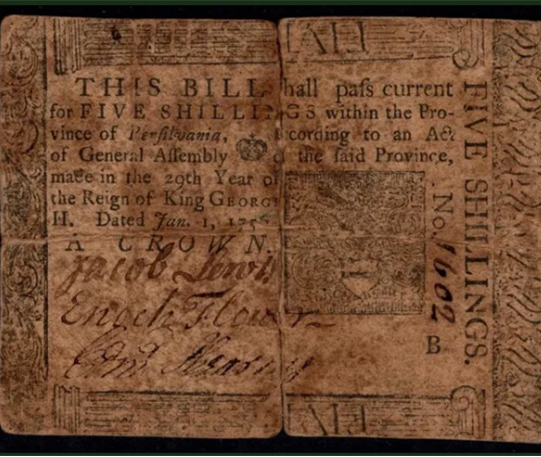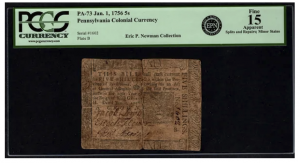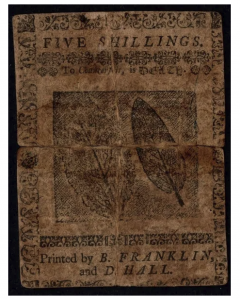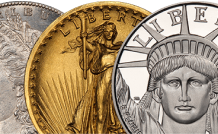
By Antoinette Rahn
“A penny saved is a penny earned.”
The same man to whom the above quote is attributed was one of America’s busiest colonists during its infancy. Inventor, writer, politician, diplomat, postmaster, Founding Father, and a printer of, among other things, colonial U.S. currency. Whew….that is quite the list of “jobs.” One has to wonder when and if Mr. Benjamin Franklin even slept.
Plus, even though Mr. Franklin was not featured in the Broadway smash hit “Hamilton,” he is the subject of lyrics penned by “Hamilton” creator Lin-Manuel Miranda. The tune, “Ben Franklin’s Song,” is the product of a collaboration between Miranda and the band, The Decemberists. My guess is, Mr. Franklin could not have imagined being the subject of a song in the 21st century, but here he is….
Musicals about Mr. Franklin’s life aside, it’s one of Mr. Franklin’s other skills and professions that I find fascinating – his job as a printer, and printer of money, to be specific. According to information available through The Franklin Institute, currency development was an important aspect of colonial life as settlers sought autonomy from the British rule and supported military efforts during the French and Indian War.
 The note that brought me on this exploration of Colonial currency is a 1756 Pennsylvania Colonial note, apparent five-shilling with a grade of PCGS15, and currently offered for sale through www.unitedstatespapermoney.com.
The note that brought me on this exploration of Colonial currency is a 1756 Pennsylvania Colonial note, apparent five-shilling with a grade of PCGS15, and currently offered for sale through www.unitedstatespapermoney.com.
Interestingly, some examples of Colonial currency printed by Mr. Franklin and his business partner and fellow printer, David Hall, have alternate spellings of Pennsylvania. Rather than an error, some believe Mr. Franklin utilized it to indicate a counterfeit note, as reported among information at The Franklin Institute. Quite clever, Mr. Franklin, if that is indeed true. The thought of this leaves me wondering if Mr. Franklin would seek a seat on the Anti-Counterfeiting Educational Foundation had he been around today?
There’s no question the history, innovation, mindset, and even mystery surrounding the formation of the U.S., and any country for that matter, can be explored and enjoyed by way of examining its early money.
To see more examples of Colonial currency, we invite you to visit the website of COINage advertiser, www.unitedstatespapermoney.com.
















